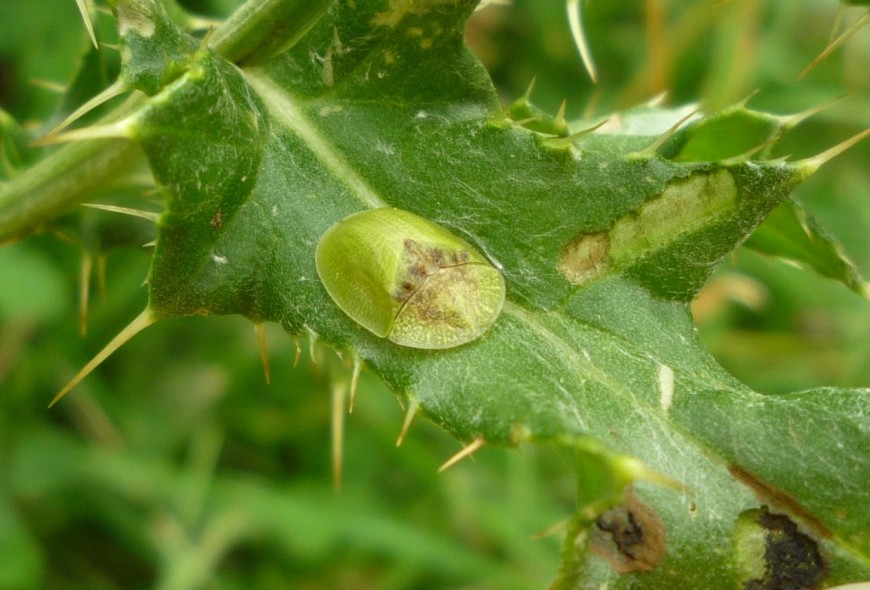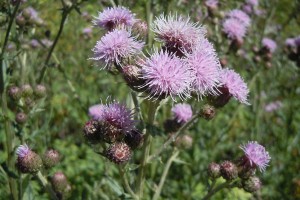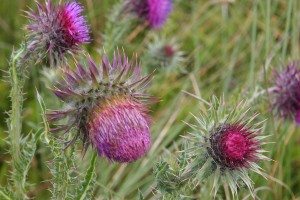Green thistle beetle
History in New Zealand
The green thistle beetle has a wide native range including Europe, eastern Mediterranean, North Asia and North Africa. The beetle was first imported in 2006 by Manaaki Whenua - Landcare Research on behalf of the Californian Thistle Action Group. The first releases were made towards the end of 2007. Widespread releases are now underway and the beetle appears to be establishing readily at many sites. This beetle was accidentally introduced to Canada more than a century ago. The green thistle beetle has also been established as a biocontrol agent in Virginia, USA, but it not been distributed to other parts of North America because of the risk of damage to native thistles there.
How would I find/recognise them and what is their lifecycle?
Adults emerge on warm days towards the end of winter and feed on the first thistle leaves to appear in the spring, making round holes in them. Look for the adults feeding on thistles from early spring until late autumn. They are oval and green in colour, with a brown spot in the centre at the top of the wing covers and they are black underneath. The adults are about 6–7.5 mm long with females being slightly larger than males. The adults are long-lived, surviving for around 80 weeks.
Image: green thistle beetle (Cassida rubiginosa).
Image: green thistle beetle (Cassida rubiginosa).
Females lay groups of eggs in a brownish case on the undersides of the leaves at the base of plants. They lay eggs for a 6 week stretches with 7 week breaks in between throughout the warmer months. This means that the females are quite prolific, laying as many as 1000 eggs each during their life time. Because the egg-laying period is protracted we expect that there will often be all life stages present at the same time.
The eggs hatch after about a week and the creamy-white larvae are also extremely distinctive. They have prominent lateral spines and a forked tail spine on which it accumulates moulted skins and excrement which it holds as a protective parasol over its back. Look for the larvae during late spring through until early autumn. The larvae feed and grow through five instars. The three youngest instars feed on and make windows mainly on the undersides of the leaves with the last two instars attacking the leaves from the top.
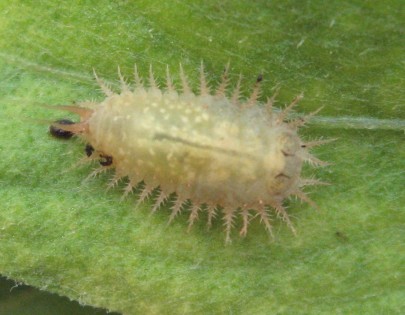
Image: green thistle beetle young larva.
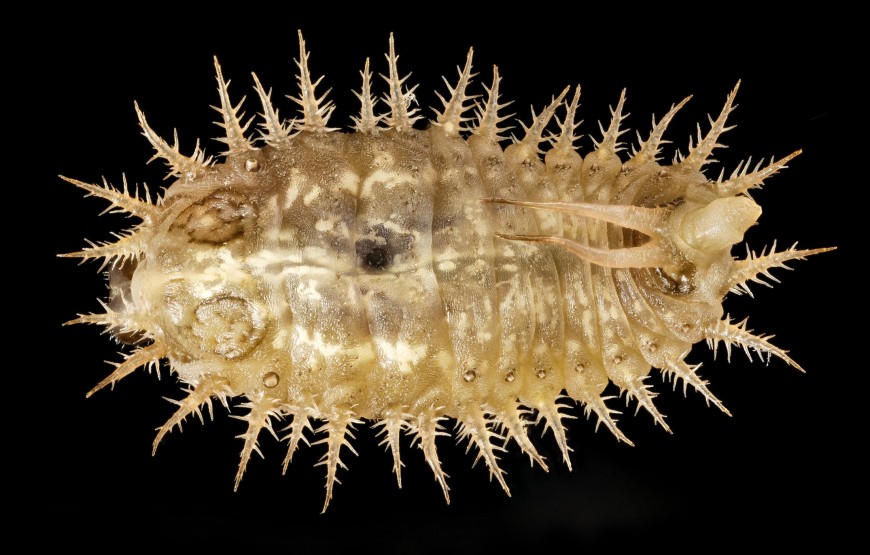
Image: green thistle beetle young larva. Photo credit: Eastern Ecological Science Center via USGS.gov.
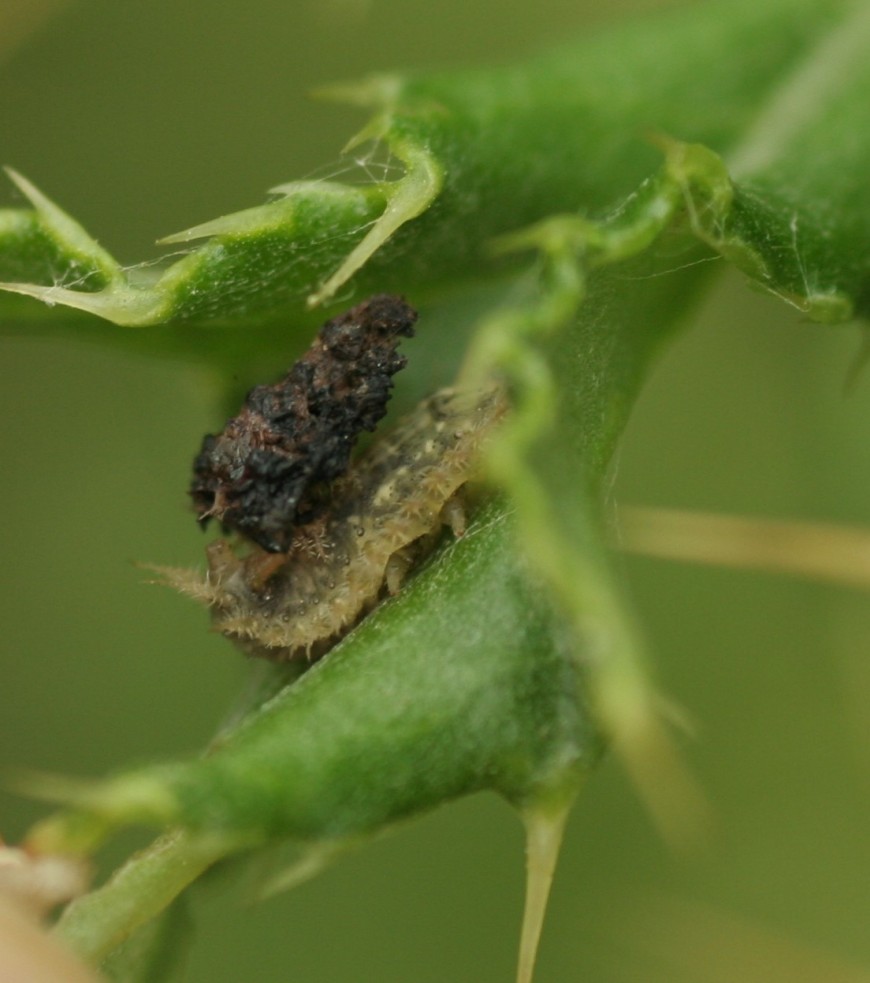
Image: green thistle beetle late instar larva carrying moulted skins and excrement on its tail spines.
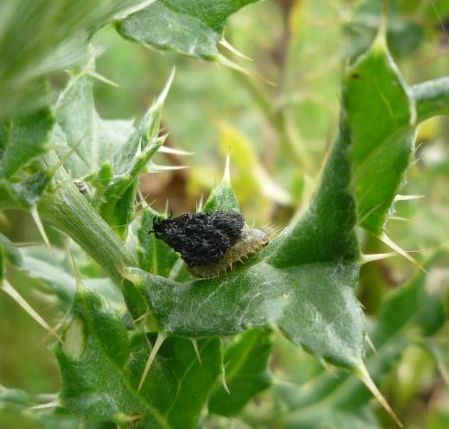
Image: green thistle beetle late instar larva.
The brown pupae with black spines around the edges also quite easy to recognise. They are attached to a leaf or stem and if disturbed flap like a hinge. Development of an egg to an adult takes around 6 weeks, and we expect that there will be only one generation produced a year. Green thistle beetles are easy to differentiate from other thistle biocontrol agents or insects on thistles.
See Californian thistle gall fly, Californian thistle leaf beetle, Californian thistle stem miner.
How do they damage thistles?
While the adults make some holes in the leaves the main damage is caused by the larvae which can defoliate plants.
Image: feeding damage caused by the green thistle beetle.
Will they attack other plants?
The beetle prefers Californian thistle but is likely to attack all thistles to some extent. Plants outside the Cardueae tribe are unlikely to be attacked. In lab tests the beetle fed on globe artichoke (Cynara scolymus) and safflower (Carthamus tinctoria). In laboratory tests the beetle will attack these plants, but given that there are no records of the beetle ever being a pest on these plants in Europe or the USA, damage to these plants in the field is believed to be unlikely to occur.
How effective are they?
It is too soon to know what impact the beetles will have here. In dry years in Virginia, USA, five parasite-free beetles per plant have been shown to reduce above ground thistle biomass by 88%, and only 25% of plants survived to the end of the following year. In wet years the impact was less but still substantial. In Ontario parasitoids keep the density of the beetles below the threshold required to have an impact. We do not know of any parasitoids in New Zealand that will attack the beetles.
How can I get the most out of this agent?
If the beetle establishes at initial release sites it would be worth helping to establish them in all areas where they are needed.
How do I select a release site?
Read Guidelines for selecting release sites for biocontrol agents.
How do I collect them for release at other sites?
We expect that the best way to collect these beetles will be using a garden-leaf vacuum machine. You could also use an ordinary vacuum cleaner if you have access to a portable generator. Modify the tube so that the beetles are collected and not sucked through. Take a sleeve of coarsely-woven material, with one end sewn shut and the other end open (old socks or pantyhose could be used), and fit it securely around the end so that it forms a bag in the mouth of the tube.
You will find it easier to vacuum shorter plants because you can form a better seal with the ground. Every 10 minutes or so, take the sleeve off the end and tip the contents into a holding container. We recommend that you shift at least 50 adults in the spring. Use a pooter to separate them from other material collected during the vacuuming process, which may include pasture pests.
How do I manage the release sites?
Avoid any activities that will interfere with the beetles, such as herbicide application. If you need to undertake control measures, then avoid the release site.
